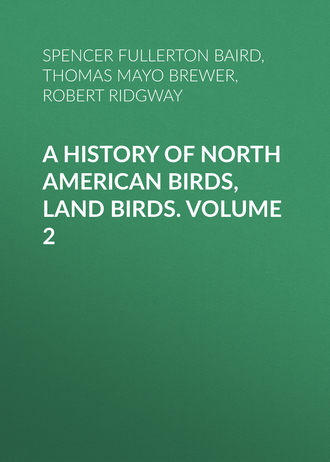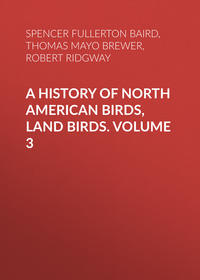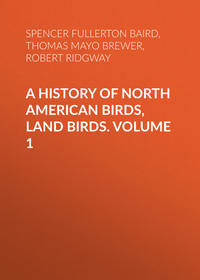 полная версия
полная версияA History of North American Birds, Land Birds. Volume 2
The S. latirostris (Aulanax l. Cab. & Hein. Mus. Hein. ii, p. 68; Sayornis l. Scl. Cat. Am. B. 1862, 200), from Ecuador, we have not seen. It is probably also referrible to the same type.
81
Contopus lugubris, Lawr. Ann. N. Y. Lyc. VIII, 1865, 134 (Costa Rica, Baranca).
82
Contopus brachytarsus, Sclater, Cat. Am. B. 1862, 231. (Empidonax brachyt. Scl. Ibis, 1859, p. 441.) A strongly marked race, but distinguishable from schotti only by just appreciable differences in color (being paler beneath), and shorter wing and bill, the latter broader at the tip.
83
Contopus (brachytarsus var. ?), var. schotti, Lawr. Ann. N. Y. Lyc. IX, 1869, 202 (Yucatan). Very nearly related to C. richardsoni, but easily distinguished by the very different proportions.
84
Contopus caribæus (D’Orb.) Muscipeta caribæa, D’Orb. (R. de la Sagra), Hist. Cuba, 1839, 77.
85
Contopus caribæus, var. hispaniolensis, Bryant. Tyrannula caribæa, var. hispaniolensis, Bryant, Pr. Bost. Soc. XI, 1866, 91.
86
Contopus caribæus, var. pallidus (Gosse). Myiobius pallidus, Gosse, Birds Jam. 166. Blacicus pallidus, Scl. P. Z. S. 1861, 77. Contopus p. Scl. Catal. Am. B. 1862, 231.—March, Pr. Ph. A. N. Sc. 1863, 290.
87
Contopus (caribæus var. ?) bahamensis, Bryant. Empidonax bahamensis, Bryant, List of Birds of the Bahamas, 1859, p. 7. Young with the colors more ashy above, and less yellowish beneath; the upper parts with feathers faintly tipped with paler, causing an obsolete transverse mottling; two distinct bands on wing of pale ochraceous.
Of the above, caribæus, hispaniolensis, and pallidus are clearly to be referred to one species; the C. bahamensis also has many characters in common with them, and no violence would be done by referring it, also, to the same type; it is, however, more modified from the standard than any of the others, though the modifications are not of importance.
88
These measurements are not only those of United States and Mexican examples, but also of Middle American examples (“sordidulus,” Sclater, and “plebeius,” Cabanis), and of a series from Ecuador and New Granada (= “bogotensis,” Sclater). In comparing a quite large number of such Middle American and Equatorial specimens with the large series of Northern examples, we have been utterly unable to appreciate even the slightest difference between them.
The C. punensis (Lawr. Ann. N. Y. Lyc. IX, 1869, 237; Puna Island, Guayaquil) is founded upon an immature specimen, so the characters of the species cannot be given with exactness. The relationship appears very close to the C. caribæus, there being the same large, very depressed bill, with the long bristles reaching nearly to its tip, and the tail about as long as the wing; while the upper plumage has the light faint transverse mottling seen in the young caribæus, var. bahamensis, and the lining of the wing ochraceous. In colors, however, the two are very different, the young of punensis being ashy-green, instead of pure ash, on the back, the crown very much darker, instead of not appreciably so; the wing-bands are white instead of ochraceous, while the breast and sides are dull sulphur-yellowish, instead of ashy, without any yellow tinge. The measurements are as follows: Wing, 2.60; tail, 2.60; culmen, .72; tarsus, .56.
The C. ochraceus, Sclater & Salvin (P. Z. S. 1869, 419; Salv. Ibis, 1870, 115), of Costa Rica, we have not seen. From the description, however, it seems to be scarcely different from C. lugubris, and it is probably the same. The size (wing, 3.30) appears to be a little smaller, and the belly more deeply yellowish.
89
Empidonax brunneus, Ridgway. A very distinct species, not needing comparison with any other.
90
Empidonax axillaris, Ridgway.
91
Empidonax flavescens, Lawr. May be the southern form of bairdi, but differ in some apparently essential features.
92
Empidonax bairdi, Sclater, P. Z. S. 1858, 301; Ibis, 1859, 442; Catal. Am. B. 1862, 230.—Sclater & Salvin, Ibis, 1860, 36. (Hab. Cordova, Coban, Mazatlan, Mirador, etc.)
93
Empidonax fulvipectus, Lawr. Ann. N. Y. Lyc. Feb. 1871, 11. (Type examined.) A very distinct species, most nearly related to obscurus, from which it differs totally in color and in much shorter tarsus.
94
Empidonax minimus, var. pectoralis. Empidonax pectoralis, Lawr. It seems but reasonable to consider this bird as the southern race of minimus, as the differences—i. e. smaller size and whiter wing-bands—are just what we find in several other species of the same region, compared with allied and probably co-specific northern types,—as griseigularis and acadicus, southern specimens of trailli var. pusillus in which the wing-bands are much whiter than in northern specimens of the same bird.
95
Empidonax griseipectus, Lawr. May possibly be another seasonal plumage of the same species as pectoralis, but differs in some seemingly important respects.
96
Empidonax acadicus, var. griseigularis. Empidonax griseigularis, Lawr. Differing from acadicus only in smaller size and whiter wing-bands.
The remaining described American species of Empidonax, which we have not seen, are the following:—
Empidonax magnirostris, Gould, Voy. Beagle, pl. 8.—Gray, Hand List.
Empidonax albigularis, Sclater & Salvin, Ibis, 1859, p. 122 (Orizaba).—Sclater, Catal. Am. B. 1862, 229. This may possibly be the species described above as E. axillaris.
97
Mitrephorus fulvifrons. Muscicapa fulvifrons, Giraud, 16 species Texas birds, 1841, pl. ii (Mexico?). Empidonax fulvifrons, Sclater, P. Z. S. 1858, 301. Mitrephorus fulvifrons, Sclater, P. Z. S. 1859, 45. Empidonax rubicundus, Cabanis, Mus. Hein. ii, 1859, 70 (Mexico). Hab. Northern Mexico.
98
Pyrocephalus obscurus, Gould, Zoöl. Voy. Beag. iii, 45.—Sclater, P. Z. S. 1859, 46; Catal. Am. B. 1862, 228 (Peru).
99
Pyrocephalus rubineus, (Bodd.) Cab. Muscicapa rubinea, Bodd. (ex Buff. pl. enl. cclxv, f. 1). Pyrocephalus r. Cabanis et Hein. Mus. Hein. ii, p. 67.—Sclater, Catal. Am. B. 1862, 227.
100
Pyrocephalus rubineus, var. nanus, Gould, Zoöl. Beag. iii, 45, pl. vii.—Sclater, P. Z. S. 1859, 46, 144; 1860, 282, 295; Catal. Am. B. 1862, p. 228. The last is hardly separable by the characters given, as, although they are never seen in southern specimens, they are not constant in the northern ones. Specimens of nanus are as large as any of rubineus, there being in every region a great range of variation in dimensions.
101
This confounding of the two sexes has probably resulted from guess-work of the collector, who, noticing the marked difference between the male and female, and naturally supposing the former to be the more brightly colored, marked the rufous-breasted specimens accordingly; while the few marked correctly may have been thus labelled after careful dissection.
102
Nyctidromus albicollis. Caprimulgus albicollis and guianensis, Gmelin, S. N. I, 1788, 1030. Nyctidromus americanus, Cassin, Pr. A. N. S. 1851, 179. Nyctidromus guianensis, derbyanus, grallarius,—affinis of authors. Nyctidromus albicollis, Sclater, P. Z. S. 1866, 145. Hab. From Northern Mexico southward to Ecuador and Brazil.
103
Chordeiles popetue, var. minor, Cabanis. Chordeiles minor, Cab. Journ. f. Orn. 1856, p. 5.—Sclater, Catal. Am. B. 1862, 279. Ch. gundlachi, Lawr. Ann. N. Y. Lyc. VI, 165.
104
Chordeiles acutipennis, (Bodd.) Cass. Caprimulgus acutipennis, Boddært, Tab. Pl. Enl. p. 46 (1783). Chordeiles a. Cassin, P. A. N. S. 1851 (Catalogue of Caprimulgidæ, in Mus. Philad. Acad.). Caprimulgus acutus, Gmel. C. pruinosus, Tschudi. C. exilis, Lesson. Chordeiles labeculatus, Jardine. “Caprimulgus semitorquatus, L., Gm., Pr. Max.” Tschudi. Chordeiles peruvianus, Peale. Hab. South America.
105
The females differ simply in having the light tail-space much reduced in size, and dull ochraceous, instead of whitish; in that of carolinensis it is wanting altogether.
106
Antrostomus macromystax (Wagl.?) Sclater, P. Z. S. 1866, 137 (La Parada, Mex..). ? Caprimulgus macromystax, Wagl. Isis, 1831, p. 533.
107
Antrostomus macromystax, var. cubanensis (Lawr.) Antrostomus cubanensis, Lawr. Ann. N. Y. Lyc. VII, May, 1860, p. 260.
108
Panyptila cayanensis (Gmel.), Cab. Hirundo cay. Gmelin, Syst. Nat. I, 1024. Panyptila cay. Caban. Wiegm. Archiv, XIII, 345 (1847).—Scl. P. Z. S. 1866, 606.
109
Panyptila sancti-hieronymi, Salvin (P. Z. S. 1863, 190, pl. xxii; Scl. P. Z. S. 1866, 607). May be the northern form of cayanensis, which, however, we have not seen.
110
Chætura poliura, (Temm.) Scl. Cat. Am. B. 1862, 101; P. Z. S. 1866, 611. (Cypselus polivurus, Temm. Tab. Méth. p. 78.)
111
Chætura cinereiventris, Scl. Cat. Am. B. 1862, p. 283; P. Z. S. 1863, p. 101, pl. xiv, f. 1; P. Z. 1866, 612. C. sclateri, Pelz. Orn. Braz. I, 1868, pp. 16, 56, is also referrible to it as perhaps a race.
112
Chætura spinicauda, Scl. Cypselus spinicaudus, Tem. Tabl. Méth. p. 78 (ex Buff. Pl. Enl. 726, f. 1). Acanthylis s. Boie, Isis, 1826, p. 971; Bonap. Consp. p. 64. Chætura s. Scl. Catal. Am. Birds, 1862, 283. Hirundo pelasgia, var., Lath. Ind. Orn. II, 581. Hab. Cayenne and Brazil.
113
Genus Lampornis, Swains. Char. Size large (wing, 2.50); tail large, more than half the wing, the feathers very broad; usually a little rounded, sometimes slightly emarginated (as in L. mango, L. virginalis, and L. aurulentus). Bill cylindrical, considerably curved, its vertical thickness least at about the middle. Nasal opercula nearly covered by the frontal feathers; tarsi naked. Wing very long, reaching to or beyond the tip of the tail; first primary longest, only slightly bowed, and not attenuated at tip; inner primaries normal.
The species of this genus belong chiefly to the West India Islands and to Tropical America,—principally on the Atlantic coast. They are all of more than the average size, and distinguished by broad tail-feathers, and rather dull, though handsome colors. In L. porphyrurus the sexes are alike in color. The following species has been accredited to North America, but probably upon erroneous data, since it belongs to northern South America, not even being an inhabitant of any of the West India Islands, except Trinidad. Still it is possible that, as alleged for Thaumatias linnæi (see page 1064), it may have wandered far from its usual habitat, and have reached Florida, as stated by Mr. Audubon.
Lampornis mango, (L.) Swains.—The Mango Hummer. Trochilus mango, L. S. N. I, 191.—Gmel. S. N. I. 491.—Aud. Orn. Biog. II, 1834, 486; pl. 184.—Ib. Birds Am. IV, 1842, 186, pl. ccli. Lampornis mango, Sw. Zoöl. Journ. III, 358.—Baird, Birds N. Am. 1858, 130. Sp. Char.—Male: Above deep golden green; beneath opaque velvety-black medially, from the bill to the anal region, separated from the lateral and superior green by a tint of metallic greenish-blue. Tail richly metallic rufous-purple, the feathers bordered terminally with blue-black; intermediæ plain dark bronzy-green. Primaries plain dull dusky. Female. Similar, but white beneath, except laterally, and with a medial stripe of black, from the bill to the anus. Wing, 2.60-2.70; tail, 1.50-1.70; bill, .90. Hab. Northern South America (Brazil, Guiana, Venezuela, New Granada, Panama, and Trinidad); accidental in Florida???
114
Calypte helenæ, (Lemb.) Gould, Monog. Troch. III, pl. cxxxvi. Orthorhynchus helenæ, Lemb. Aves de l’Isle de Cuba, p. 70, pl. x, fig. 2. O. boothi, Gundl. MSS. (Gould, Monog.).
115
Calypte floresi, (Lodd.) Trochilus floresi, Lodd. MSS. Selasphorus floresi, Gould, Monog. Troch. III, pl. cxxxix. There are certainly few reasons for considering this bird as a Selasphorus, while there are many for referring it to Calypte. The only feature that it shares with the former is the peculiar coloration, and to some extent the shape, of the tail. However, in Selasphorus the outer primary is always (in the male) attenuated and acute at the tip, and the crown is never metallic, while in Calypte the outer primary is never attenuated nor acute, and the crown of the male is always metallic. The form and coloration of the tail are nothing more than a specific character, since no two species, of either genus, agree in this respect. In view, then, of these considerations, we find floresi to be strictly congeneric with the other species of Calypte.
116
Selasphorus (platycercus, var. ?) flammula (Salv.). Selasphorus flammula, Salvin, P. Z. S. 1864 (Costa Rica). (Described above from specimen in Mr. Lawrence’s collection.)
117
Selasphorus (rufus var. ?) scintilla (Gould). Selasphorus scintilla, Gould, P. Z. S. 1850, 162, Monog. Troch. III, pl. cxxxviii. The foregoing species are so similar in all essential respects to the northern S. platycercus and S. rufus, that it is exceedingly probable that they are merely the southern forms of those species. Both differ in exactly the same respects from their northern representatives, namely, in smaller size and less burnished throat, and to a very slight degree only in form. The only specimen of the S. flammula that we have examined is a badly shot male in Mr. Lawrence’s collection; what appears to be the outer primary in this specimen is not attenuated at the tip, which is curved inward, instead of acutely attenuated and turned outward as in platycercus; the wings are badly cut with shot, however, and the first primary may be wanting.
118
Heliopædica melanotis, (Swains.) Gould, Monog. Troch. II, pl. lxiv. Trochilus melanotus, Swains. Phil. Mag. 1827, 441. Trochilus leucotis, Vieill. Ornismyia arsenni, Less. Hab. Mexico and Guatemala.
119
Am. Naturalist, 1869-70.
120
Geococcyx affinis, Hartlaub, Rev. Zoöl. 1844, 215.—Bonap. 97.—Scl. P. Z. S. 1858, 305.—Sclater & Salvin, Ibis, 1859, 134.—Sclater, Catal. 1862, 325. Geococcyx velox, Karw. Bonap. 97.
121
Coccygus melanocoryphus, Vieillot, Nouv. Dict. VIII, 271.—Sclater, Catal. 1862, 323.—Ib. P. Z. S. 1864, 122.
122
Crotophaga major, Linn. Syst. Nat. I, 363.—Max. Beitr. IV, 319.—Scl. Cat. 1862, 320. C. ani, Vieill. Gal. Ois. II, 35, pl. xliii.
123
Crotophaga sulcirostris, Swainson, Phil. Mag. 1827, I, 440.—Bonap. Consp. 89.—Scl. P. Z. S. 1856, 309, 1859, pp. 59, 368, 388, et 1860, pp. 285, 297.—Ib. Catal. 1862, 320. C. casasi, Less. Voy. Coq. Zoöl. I, pl. ii, 619, et Cent. Zoöl. pl. ix.
124
Conspectus avium picinarum. Stockholm, 1866.
125
A character common to all the members of the genus, and distinguishing them from the species of every other; this peculiar form of the middle tail-feathers is caused principally by a folding of the webs downward, almost against each other. The under surfaces of the shafts have a very deep groove their whole length, which is seen in no other genus.
126
Campephilus bairdi, Cassin, Pr. A. N. Sc. 1863, 322 (Cuba).—Gundlach, Repertorium, I, 1866, 293.—Ib. Cab. Jour. 1866, 352. Hab. Cuba.
127
Picoides tridactylus, var. tridactylus. Picus tridactylus, Linn. S. N. 12th ed. I, 177 (1766).—Degland, Orn. Eur. I, 161 (1849). Apternus tridactylus, Bonap. Birds (1838), p. 9.—Gould, Birds of Europe pl. ccxxxii. Picoides tridactylus, Gray. Picoides europæus, Less. Orn. p. 217 (1831).
128
Picoides tridactylus, var. crissoleucus. Picus crissoleucus, Brandt, Mus. Petrop. Apternus crissoleucus, Bonap. Consp.—Reich. Syn. p. 362, No. 836; pl. dcxxxi, f. 4197, 4198. Picoides crissoleucus, Malh. Monog. Pic. I, 180. “Apternus kamtchatkensis, Bonap.”—Malh. Monog. Pic. I, 180 (in synonomy). Apternus tridactylus, Mus. de Mayence.—Pallas, Zoogr. Ros. As. I, 415.
129
Centurus carolinus, var. tricolor. Picus tricolor, Wagl. Isis, 1829, 512. Centurus tri. Scl. Catal. Am. B. 1862, 343. C. subelegans, Scl. P. Z. S. 1855, 162; 1856, 143.
130
Centurus aurifrons, var. hoffmanni. Centurus hoffmanni, Cabanis, Journ. Sept. 1862, 322 (Costa Rica).
131
Melanerpes formicivorus, var. striatipectus, Ridgway. In view of the very appreciable difference from the other races named, it appears necessary to name this one, in order that it may rank equally with the rest. The almost entirely streaked breast is only an approach to what we see, in its extreme phase, in the var. flavigula. The black vertex of the female appears broader than in specimens of var. formicivorus.
132
Melanerpes formicivorus, var. flavigula, Natt. Melampicus flavigula (Natt.), Malh. Rev. Zoöl. 1849, 542, Monog. Pic. II, 202, pl. xcix, f. 5, 6. Melanerpes flavigularis, Scl. P. Z. S. 1856, 161. This can only be considered the melanistic extreme of a species of which the var. formicivorus is the rubescent one, the transition being gradual through the var. striatipectus of the intermediate region.
133
Colaptes mexicanoides, Lafr. Rev. Zoöl. 1844, 42.—Scl. & Salv. Ibis, 1859, 137.—Scl. Catal. Am. B. 1862, 344. Colaptes rubricatus, Gray, Gen. B. pl. cxi. Geopicus rub. Malh. Monog. Pic. II, 265, pl. cx, figs. 1, 2. Picus submexicanus, Sund. Consp. Pic. 1866, 72.
134
A series of hybrids between mexicanus and auratus is in the Smithsonian collection, these specimens exhibiting every possible combination of the characters of the two.
135
Colaptes auratus, var. chrysocaulosus. Colaptes chrysocaulosus, Gundlach, Boston Journal.—Ib. Repert. I, 1866, 294.
136
Die Papageien. Monographisch bearbeitet von Otto Finsch. 2 vols. Leiden, 1867, 1868.
137
A. Tail longer than the wings; lores and cheeks naked; the latter with narrow lines of small feathers.
S. militaris. Green; forehead red; posterior portion of back, upper and under tail-coverts with quills and tip of tail, sky-blue; under side of tail dirty orange-yellow. Wing, 14.00; middle tail-feathers, 15.00; tarsus, 1.08. Hab. Northwestern Mexico to Bolivia.
Synonymy: Psittacus militaris, Linn. S. N. 1767, 139. Sittace militaris, Finsch, Die Papageien, I, 1867, 396.
B. Tail about equal to the wings; lores and cheeks feathered.
S. pachyrhyncha. Green; the forehead, edge of wings, and the tibiæ red; greater under wing-coverts yellow. Wing, 8.00 to 10.00; middle tail-feather, 6.50. Hab. Southern Mexico (Jalapa and Angangueo), given probably erroneously from the Rio Grande of Texas. Synonymy: Macrocercus pachyrhynchus, Sw. Syn. Birds Mex. in Philos. Mag. I, 1827, 439, No. 79. Rhynchopsitta pachyrhyncha, Bon. Tableau des Perroquets, Rev. et Mag. de Zoöl. 1854, 149. Sittace pachyrhyncha, Finsch, Die Papageien, I, 1867, 428. Psittacus pascha, Wagler, Isis, 1831, 524. Psittacus strenuus, Licht. Preis-Verzeichiss, 1830.





